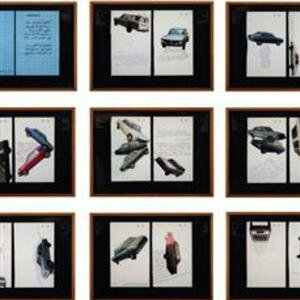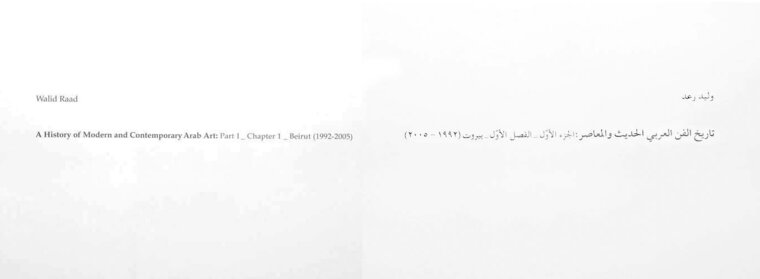


Last updated on Thu 17 July, 2008


A History of Modern and Contemporary Arab Art
Sfeir-Semler Gallery is pleased to present the first Beirut solo exhibition by Walid Raad titled: A History of Modern and Contemporary Arab Art _ Part I _ Chapter 1: Beirut 1992-2005. The exhibition includes six new works, including mixed media installations, sculptural works, and photographs. Over the past ten years, the Arab world has witnessed the emergence of a number of contemporary art festivals, art funds, cultural institutions, art galleries, art fairs, and collectors of contemporary art. Moreover, the planned construction of several large art museums and art schools in the Arab Gulf raises a number of questions about how culture, and in particular contemporary visual art will be conceived, made, distributed, and consumed in the future, not only in the Gulf, but in the Arab world in general, and beyond. Needless to say, these developments are part of a broader economic trend whereby cultural tourism figures more and more as an engine of economic growth, as has been evident in Europe, North and South America, and the Near and Far East.
In 2008, Walid Raad initiated a research project about the history of contemporary and modern Arab art. On the one hand, his project aims to identify and unpack the ideological, economic, and political dimensions of this recent fascination with visual art in the Arab world. On the other hand, and proceeding from the writings of Jalal Toufic and his concept of “the withdrawal of tradition past a surpassing disaster,” Raad intends to examine whether and how culture and tradition in the Arab world may have been affected, materially and immaterially by the various wars that have been waged there by native and external powers.
Raad’s exhibition in the Sfeir-Semler Gallery is his first solo show in Lebanon and the Middle East. The exhibition is titled A History of Modern and Contemporary Arab Art _ Part I _ Chapter 1: Beirut 1992-2005. With this exhibition, Raad presents the first chapter of his on-going art project. The works concentrate on a range of concerns, from the above-mentioned emergence of a high art infrastructure in Beirut over the past fifteen years (the advent of not-for-profit cultural institutions, white cube galleries, grassroots festivals, national biennale participation, etc.) to a close study of the question of intra-art historical reference in fellow artists’ artworks. In this sense, Raad presents two complimentary propositions. He proposes an analysis of the local, regional, and international “fascination” with artworks and artists form the Arab world and Lebanon. And he creates works of art where the very buildings blocks of his images and forms are precisely the elements (contemporary and historical) made available by this emerging infrastructure for the creation, distribution, and consumption of Arab artworks and artists. Moreover, he creates artworks that attempt to be referential, in the sense that they hail other Lebanese and non-Lebanese artists and artworks.
Raad’s exhibition is divided into 6 sections, each occupying a distinct space in the gallery. The exhibited sections are titled:
- Preface: Title 23
- Appendix XVIII: Plates
- The Atlas Group (1989-2004)
- Museums
- Walid Sadek’s Love Is Blind (Modern Art, Oxford, U.K.)
- Index XXVI: Artists.
As such, the exhibition takes the form of an unfolding book or research project, sections of which are made available in the gallery. Each section considers an element of this amorphous field for the production, distribution, and consumption of artists and artworks in Lebanon. For example, in the section titled Appendix XVIII: Plates, Raad creates images using colors, texts, and images extracted from various documents he has been gathering over the past few years such as exhibition and festival catalogs, art school mission statements, theoretical publications, museum proposals, artists indexes, art historical dissertations and theses, and art market data). These documents are here deployed as formal elements in six large photographic triptychs (175 X 405 cm. each). Book and exhibitions titles, book covers, and office stationary here become the building blocks and forms for the creation of seemingly abstract and highly formalized images.
In the section titled Index XXVI: Artists, Raad displays the names of over 150 artists who have worked in Beirut over the past one hundred years. The names, barely more than two centimeters in height each, are printed on white vinyl letters, and mounted in one of the gallery’s white walls in a twenty-two meter straight line. The names literally disappear and appear in the room, thus marking the white cube gallery space as the condition of both the visibility and invisibility of the artist as a figure with a name, a history, and a biography. With this exhibition, Raad expands the investigation he began with his fifteen-year art project titled The Atlas Group about the question of the document in media arts, violence and its various physical, psychological and phenomenal forms, and the possibilities and limits of creative acts. With The Atlas Group, Raad’s exploration was concentrated on historical and fictional events and situations about the wars in Lebanon over the past thirty years. In A History of Modern and Contemporary Arab Art _ Part I _ Chapter 1: Beirut 1992-2005, Raad’s objects of study are the notions of the modern and the contemporary in Arab Art, and (following the writer and artist Jalal Toufic) how creative acts by artists, writers, and other thinkers may help us think, feel, and experience how and if the violence of the past decades in Lebanon and the Arab world has affected citizens, cities, and objects but also culture and tradition broadly, materially and immaterially.
Narrative Biography
Walid Raad is an artist and an Associate Professor of Art in The Cooper Union (New York, USA). Raad’s works include The Atlas Group, a fifteen-year project between 1989 and 2004 about the contemporary history of Lebanon, and the ongoing project titled A History of Modern and Contemporary Arab Art. His books include The Truth Will Be Known When The Last Witness Is Dead, My Neck Is Thinner Than A Hair, and Let’s Be Honest, The Weather Helped.
Raad’s works have been shown at Documenta 11 (Kassel, Germany), The Venice Biennale (Venice, Italy), The Hamburger Bahnhof (Berlin, Germany), The Museum of Modern Art (New York, USA), Homeworks (Beirut, Lebanon) and numerous other museums and venues in Europe, the Middle East, and North America. Raad is also the recipient of the Alpert Award in Visual Arts (2007), the Deutsche Börse Photography Prize (2007), and the Camera Austria Award (2005).
Raad’s works are included in the following collections: The Museum of Modern Art (New York, USA), The Walker Art Center (Minneapolis, USA), The Guggenheim Museum (New York, USA), The British Museum (London, UK), Tate Modern (London, UK), Centre Pompidou (Paris, France), FNAC (Paris, France), National Galerie (Berlin, Germany), Hamburger Kunsthalle (Hamburg, Germany), MMK (Frankfurt, Germany), MOMAC (Vienna, Austria), Museion (Bolzano, Italy), Kunsthaus Zurich (Zurich, Swtzerland), among others.
Join us in our endless discovery of modern and contemporary Arab art